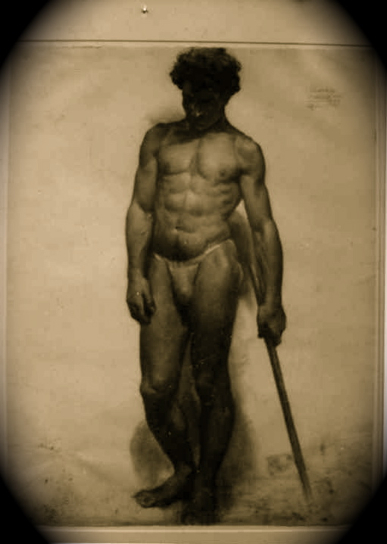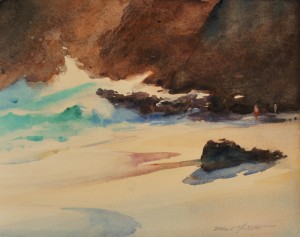
This image is one that I picked up in NYC about 15 years ago. It’s a photograph of a charcoal drawing which someone had left in the pages of a battered art book that I ended up getting for a buck or two at the Strand or somewhere.
It’s charcoal (or possibly black chalk) on paper, is probably around 24 x 18″ in the original, was most likely done by a European or American art student, someone in their early to mid twenties, and probably was drawn before the time of the First World War. I’m pretty sure it is pre-1900, but I’m only guessing. For years, one had to comb the used bookstores or print shops for evidence that such drawings were ever produced, or any information as to how such drawings were created, a situation that is thankfully reversing itself with gusto today.
I’ve kept this image and admired it since it slipped to the floor of that bookstore years ago. For myself and others like me, it affirms that there were once indeed other art students (and an art culture) for whom the careful and objective study of the visual world and the rendering of it was an exquisite delight as well as a necessary step in refining themselves as artists worthy of the title. I guess I find the situation not unlike the rediscovery of Greek art by the sculptors of Michaelangelo’s day, a startling glimpse of something no one remembered was possible.
Whether aware of it or not, the authors of such drawings typically regarded a model posing as “visual truth”. One’s mind and hand needed cultivation and discipline in order to grasp and express that truth fully. To such a student, if truly gifted, the challenge of crafting such a drawing would be a labor of love and science combined, a happy stripping away of crude and naive misconceptions of the form we inhabit in favor of enlightenment and refinement. The instructor may have been critical and demanding, and that art student wouldn’t have thought of this drawing as “art”, but as one of many necessary steps in his or her preparation for creating art.
I hope that the younger art students of today have the opportunity to be exposed to drawings such as this. I enjoy sharing them.



3 Comments
Mark, this charcoal drawing might well have been made in some atelier in the distant past. One such as has been revived by Snowden Hodges at HCC that I attended for the third year. Life drawing from models and cast statues are one of the basic teaching techniques in and atelier.
Jerry
Thanks Jerry, and I’m sure you’re right. Just my guess, but I think it’s probably American, I don’t recall seeing any European Academie drawings that had male models with “coverings”, and so I’d bet this particular piece was done in a mixed environment with male/female pupils.
Iit could have come out of the Pennsylvania Academy under Eakins or Anschutz, or maybe Cowles in Boston under one of the Boston painters. Or New York for that matter. But it’s a beautiful piece of work, and thanks for letting folks know about Snowden’s program.
if you ever want to see it, I have a copy of “The American Students of Jean-Leon Gerome” that has a few nice examples of atelier work from his students.
Your probably correct it is American of older origin concerning the cover up. In the recent Atelier in this “modern time” we had a well muscled, “Adonis” type male model such as this drawing, fully unclothed in mixed artist company for a two week session of oil figure painting.